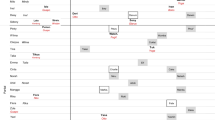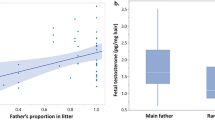Abstract
The reproductive success of male primates is not always associated with dominance status. For example, even though male orangutans exhibit intra-sexual dimorphism and clear dominance relationships exist among males, previous studies have reported that both morphs are able to sire offspring. The present study aimed to compare the reproductive success of two male morphs, and to determine whether unflanged males sired offspring in a free-ranging population of Bornean orangutans, using 12 microsatellite loci to determine the paternity of eight infants. A single flanged male sired most of the offspring from parous females, and an unflanged male sired a firstborn. This is consistent with our observation that the dominant flanged male showed little interest in nulliparous females, whereas the unflanged males frequently mated with them. This suggests that the dominant flanged male monopolizes the fertilization of parous females and that unflanged males take advantage of any mating opportunities that arise in the absence of the flanged male, even though the conception probability of nulliparous females is relatively low.

Similar content being viewed by others
References
Altmann S (1962) A field study of the sociobiology of rhesus monkeys, Macaca mulatta. Ann NY Acad Sci 102:338–435
Ancrenaz M, Gimenez O, Ambu L (2005) Aerial surveys give new estimates for orangutans in Sabah, Malaysia. PLoS Biol 3:e3
Banes GL, Galdikas BM, Vigilant L (2015) Male orang-utan bimaturism and reproductive success at Camp Leakey in Tanjung Puting National Park, Indonesia. Behav Ecol Sociobiol 69:1785–1794
Cowlishaw G, Dunbar RIM (1991) Dominance rank and mating success in male primates. Anim Behav 41:1045–1056
Delgado RA, van Schaik CP (2000) The behavioral ecology and conservation of the orangutan (Pongo pygmaeus): a tale of two islands. Evol Anthr 9:201–218
Ellis L (1995) Dominance and reproductive success among nonhuman animals: a cross-species comparison. Ethol Sociobiol 16:257–333
Fujii-Hanamoto H, Matsubayashi K, Nakano M, Kusunoki H, Enomoto T (2011) A comparative study on testicular microstructure and relative sperm production in gorillas, chimpanzees, and orangutans. Ame J primatol 73:570–577
Galdikas BM (1985a) Adult male sociality and reproductive tactics among orangutans at Tanjung Puting. Folia Primatol 45:9–24
Galdikas BM (1985b) Subadult male orangutan sociality and reproductive behavior at Tanjung Puting. Am J Primatol 8:87–99
Galdikas BM (1995) Social and reproductive behavior of wild adolescent female orangutans. In: Nadler RD, Galdikas BMF, Sheeran LK, Rosen N (eds) The Neglected Ape. Springer, Boston, pp 163–182
Goossens B, Setchell JM, James SS, Funk SM, Chikhi L, Abulani A, Ancrenaz M, Ancrenaz-Lackman I, Bruford MW (2006) Philopatry and reproductive success in Bornean orang-utans (Pongo pygmaeus). Mol Ecol 15:2577–2588
Graham C (1988) Reproductive physiology. In: Schwartz JH (ed) Orang-utan biology. Oxford University Press, Oxford, pp 91–103
Inoue E, Inoue-Murayama M, Takenaka O, Nishida T (2007) Wild chimpanzee infant urine and saliva sampled noninvasively usable for DNA analyses. Primates 48:156–159
Kalinowski ST, Taper ML, Marshall TC (2007) Revising how the computer program CERVUS accommodates genotyping error increases success in paternity assignment. Mol Ecol 16:1099–1106
Knott CD, Kahlenberg SM (2007) Orangutans in perspective: forced copulations and female mating resistance. In: MacKinnon KC, Panger M, Bearder SK (eds) Primates in perspective. Oxford University Press, New York, pp 290–305
Knott CD, Emery Thompson M, Stumpf RM, McIntyre MH (2010) Female reproductive strategies in orangutans, evidence for female choice and counterstrategies to infanticide in a species with frequent sexual coercion. Proc Biol Sci 277:105–113
Kutsukake N, Nunn CL (2006) Comparative tests of reproductive skew in male primates: the roles of demographic factors and incomplete control. Behav Ecol Sociobiol 60:695–706
Kuze N, Malim TP, Kohshima S (2005) Developmental changes in the facial morphology of the Borneo orangutan (Pongo pygmaeus): possible signals in visual communication. Am J Primatol 65:353–376
Kuze N (2005) Ethological study of semi-wild orangutans. In: Ph.D Thesis. Graduate School of Bioscience and Biotechnology, Tokyo Institute of Technology
Kuze N, Sipangkui S, Malim TP (2008) Reproductive parameters over a 37-year period of free-ranging female Borneo orangutans at Sepilok Orangutan Rehabilitation Centre. Primates 49:126–134
Lampa S, Henle K, Klenke R, Hoehn M, Gruber B (2013) How to overcome genotyping errors in non-invasive genetic mark-recapture population size estimation—a review of available methods illustrated by a case study. J Wildl Manag 77:1490–1511
Longmire JL, Maltbie M, Baker RJ (1997) Use of “lysis buffer” in DNA isolation and its implication for museum collections. Museum of Texas Tech University, Lubbock
Majolo B, Lehmann J, de Bortoli Vizioli A, Schino G (2012) Fitness-related benefits of dominance in primates. Am J Phys Anthropol 147:652–660
Mitani J (1985) Mating behaviour of male orangutans in the Kutai Game Reserve, Indonesia. Anim Behav 33:392–402
Muller M, Thompson M, Wrangham R (2006) Male chimpanzees prefer mating with old females. Curr Biol 16:2234–2238
Nsubuga AM, Robbins MM, Boesch C, Vigilant L (2008) Patterns of paternity and group fission in wild multimale mountain gorilla groups. Am J Phys Anthropol 135:263–274
Ostner J, Nunn C, Schülke O (2008) Female reproductive synchrony predicts skewed paternity across primates. Behav Ecol 19:1150–1158
Schürmann CL (1981) Courtship and mating behavior of wild orangutans in Sumatra. In: Chiarelli AB, Corruccini R (eds) Primate behavior and sociobiology. Springer, Berlin Heidelberg, pp 130–135
Setchell J (2008) Alternative reproductive tactics in primates. In: Oliveira RF, Taborsky M, Brockmann HJ (eds) Alternative reproductive tactics: an integrative approach. Cambridge University Press, Cambridge, pp 373–398
Stoinski TS, Rosenbaum S, Ngaboyamahina T, Vecellio V, Ndagijimana F, Fawcett K (2009) Patterns of male reproductive behaviour in multi-male groups of mountain gorillas: examining theories of reproductive skew. Behaviour 146:1193–1215
Trivers R (1972) Parental investment and sexual selection. Sexual selection and the descent of man. Aldine de Gruyter, New York, pp 136–179
Utami SS, Goossens B, Bruford MW, de Ruiter JR, van Hooff JA (2002) Male bimaturism and reproductive success in Sumatran orang-utans. Behav Ecol 13:643–652
Utami Atmoko SS, Singleton I, van Noordwijk MA, van Schaik CP, Mitra Setia T (2009a) Male–male relationships in orangutans. In: Wich SA, Utami Atmoko SS, Mitra Setia T, van Schaik CP (eds) Orangutans: geographic variation in behavioral ecology and conservation. Oxford University Press, New York, pp 225–234
Utami Atmoko SS, Setia TM, Goossens B, James SS, Knott CD, Morrogh-Bernard HC, van Noordwijk MA (2009b) Orangutan mating behavior and strategies. In: Wich SA, Utami Atmoko SS, Mitra Setia T, van Schaik CP (eds) Orangutans: geographic variation in behavioral ecology and conservation. Oxford University Press, New York, pp 235–244
Watts DP (2015) Mating behavior of adolescent male chimpanzees (Pan troglodytes) at Ngogo, Kibale National Park, Uganda. Primates 56:163–172
Wich SA, Utami-Atmoko SS, Mitra Setia T, Rijksen HD, Schürmann C, van Hooff JARAM, van Schaik CP (2004) Life history of wild Sumatran orangutans (Pongo abelii). J Hum Evol 47:385–398
Wroblewski EE, Murray CM, Keele BF, Schumacher-Stankey JC, Hahn BH, Pusey AE (2009) Male dominance rank and reproductive success in chimpanzees, Pan troglodytes schweinfurthii. Anim Behav 77:873–885
Acknowledgements
We are grateful to Sabah Biodiversity Centre, Sabah Wildlife Department, and Economic Planning Unit of Malaysia Federal Government for permitting this study. We are also grateful to Dr. Noko Kuze, Dr. Henry Bernard, Dr. Vijay Kumar, Ms. Sylvia Alsisto, Mr. Sailun Aris, and all the staff of the Sepilok Orangutan Rehabilitation Centre for their kind support of our research activity in Sabah, Malaysia, and to Dr. Naofumi Nakagawa for helpful comments on our manuscript. The present study was supported by Grants-in-Aid for Japan Society for the Promotion of Science (JSPS) Research Fellow (Grant no. 10J01218 to Tomoyuki Tajima); JSPS Core-to-Core Program, Advanced Research Networks “Tropical Biodiversity Conservation” Wildlife Research Center, Kyoto University, Japan, and by the Ministry of Education, Culture, Sports, Science and Technology (MEXT), Leading Graduate School Program in Primatology and Wildlife Science, Kyoto University, Japan. We obtained appropriate permission from the Sabah Wildlife Department and Sabah Biodiversity Council before conducting our research, and the study complies with current Malaysian laws, as well as with the “Guidelines for Care and Use of Nonhuman Primates” and “Guideline for field research of non-human primates” provided by the Primate Research Institute of Kyoto University, Japan.
Author information
Authors and Affiliations
Corresponding author
Electronic supplementary material
Below is the link to the electronic supplementary material.
About this article
Cite this article
Tajima, T., Malim, T.P. & Inoue, E. Reproductive success of two male morphs in a free-ranging population of Bornean orangutans. Primates 59, 127–133 (2018). https://doi.org/10.1007/s10329-017-0648-1
Received:
Accepted:
Published:
Issue Date:
DOI: https://doi.org/10.1007/s10329-017-0648-1




